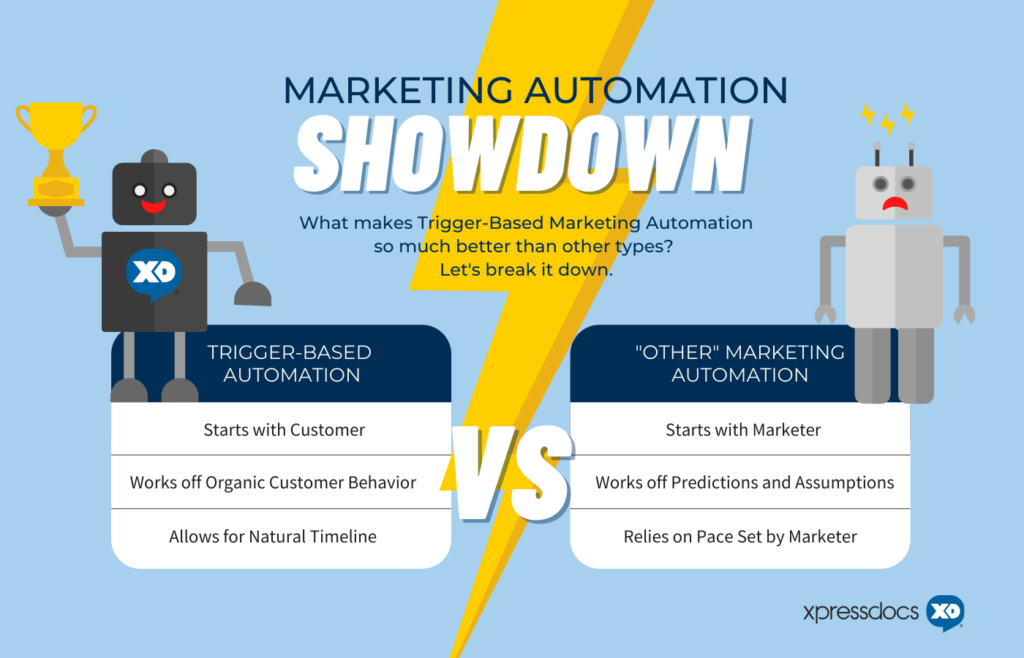Trigger Happy: Why You Should Embrace Customer-Led Automation
Reasons to Embrace Marketing Automation Software
Marketing automation, the (heaven-sent) tech that gives marketers sweet relief from mundane busywork, has a place in many modern businesses. With such a time-saving asset on your side, you might think all is well. Unfortunately, having the latest software doesn’t guarantee you’re maximizing its use.
So, let’s take a closer look at this technology to make sure it’s growing your business like the marketing gods intended.
The Flaw in Standard Marketing Automation
When designing a campaign strategy, many marketers start with a proposed timeline:
Customers X and Y will receive correspondence A. Then, when said customers take actions B or C, we will do F.
The built-in flaw with this approach is it begins with the marketer, not the customer. The business decides what materials and information the prospect receives and when. The customer journey becomes a map of speculation and contrived interactions instead of an organic path.
But if you think on it, you can admit things are rarely that straightforward. Sometimes prospects see a social media post, which leads them to a blog, after which they ask for a demo, then make a purchase.
Other times, someone stumbles on a blog, then waits months to poke around the website before experimenting with a small purchase. In real life, you can’t control what customers do or what order they do it in.
But you can control how you respond to their behaviors…which is where trigger marketing steps in.
Why Trigger Marketing Gets It Right
Trigger-based marketing involves using automation software to perform a task after a customer event or action. Meaning, marketers do nothing until the customer prompts it.
This strategy puts things in deliberate order, allowing the customer’s behaviors and preferences to lead the way. As such, marketing messages create a more personalized experience, leading to more conversions and a heartier bottom line.
The Basics of Customer-Led (Trigger) Automation
Perhaps the easiest way to think about trigger-based marketing is in ifs and thens. Because the tech is beautifully simple.
If x happens, then do y.
And there are approximately fifty bajillion combinations you can create. If someone fills out this form, send this email. If someone abandons an empty cart, send this postcard with an offer for 20% off. You can even set up triggers for non-action items, like birthdays or customer anniversaries.
Part of what makes this software universally beloved is its ability to scale. Your triggers and corresponding actions can be as simple or sophisticated as your master plan allows. More importantly, your customer-led automation journey demands only 3 steps:
- Define a trigger.
- Determine what action your system will perform.
- Create personalized messaging.
Examples and Use Cases
This tech supports a variety of messaging mediums. You can use it to send emails, direct mail, or even alert customer service agents to reach out directly. If you’re particularly savvy, you might make use of multiple channels, depending on the situation.
This is where it helps to know your customer.
If someone spent time viewing certain content on your website (industry case studies, blogs, etc.), you can tailor follow-up messages accordingly. You could also analyze your CRM data to see if there’s a point in your pipeline where communication drops off.
Is there a form someone fails to complete or a web page they get stuck on? Maybe shoot them an email asking how you can help. You’d be surprised how often people respond to an offer for guidance.
Here are some of the most popular triggers businesses use:
- Special occasions – Send emails or direct mail goodies to celebrate customer birthdays or service anniversaries.
- Abandoned shopping carts – Use this opportunity for email retargeting or promotional discounts.
- Live or digital events – Have a webinar coming up? Send a reminder beforehand or a follow-up afterward (with a downloadable PDF summary or recording).
- Transactions – Whether someone downloaded an ebook or made a purchase, use the moment to say thank you and encourage further engagement.
- Inactivity – Has it been a while since a customer made a purchase? Maybe they spent significant time on your website but didn’t take the final step. Whatever the case, you can determine the best way to reach out and nudge them along.
- Reminders – Life gets busy, and sometimes people forget about upcoming appointments or scheduled services.
Bottom line—research and planning must happen before you can set up effective action plans. But if you put in the hours and effort, few strategies work better than trigger marketing.
Of course, you’ll want to make sure to send relevant, personalized messages. It would be a shame to set up perfect triggers but have the communication fall flat.

So don’t get burned by low-response campaigns or meh printing quality. At Xpressdocs, we not only have top-tier marketing automation software, but we can help you design eye-catching direct mail, print your goods on state-of-the-art presses, AND mail them for you. Because friends don’t let friends wait in line at the post office.